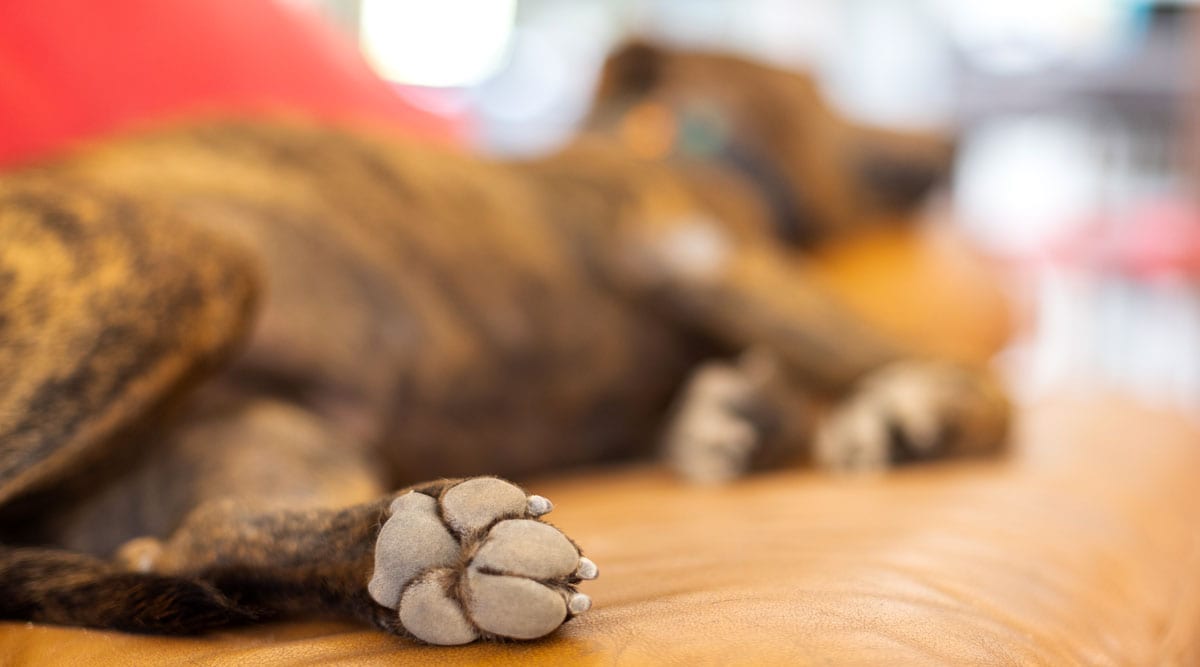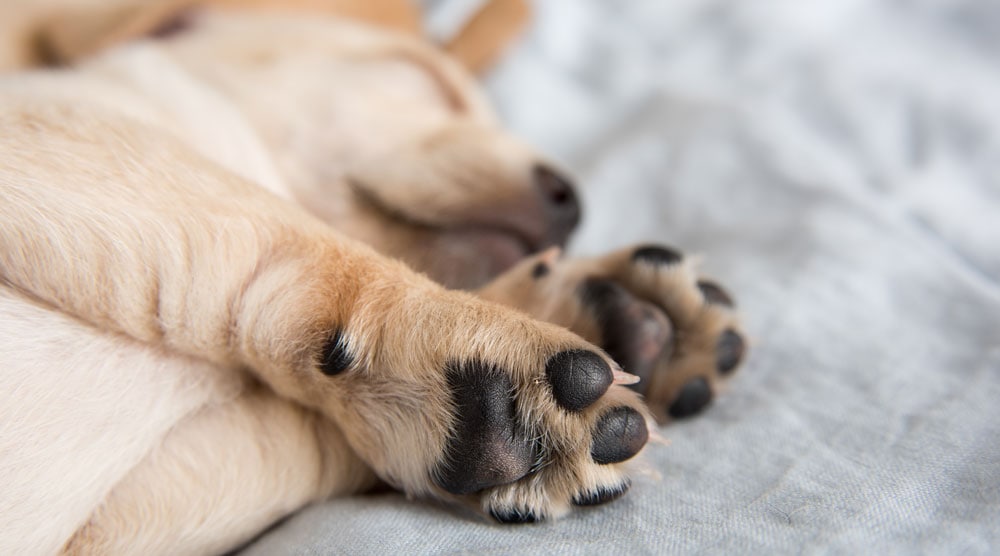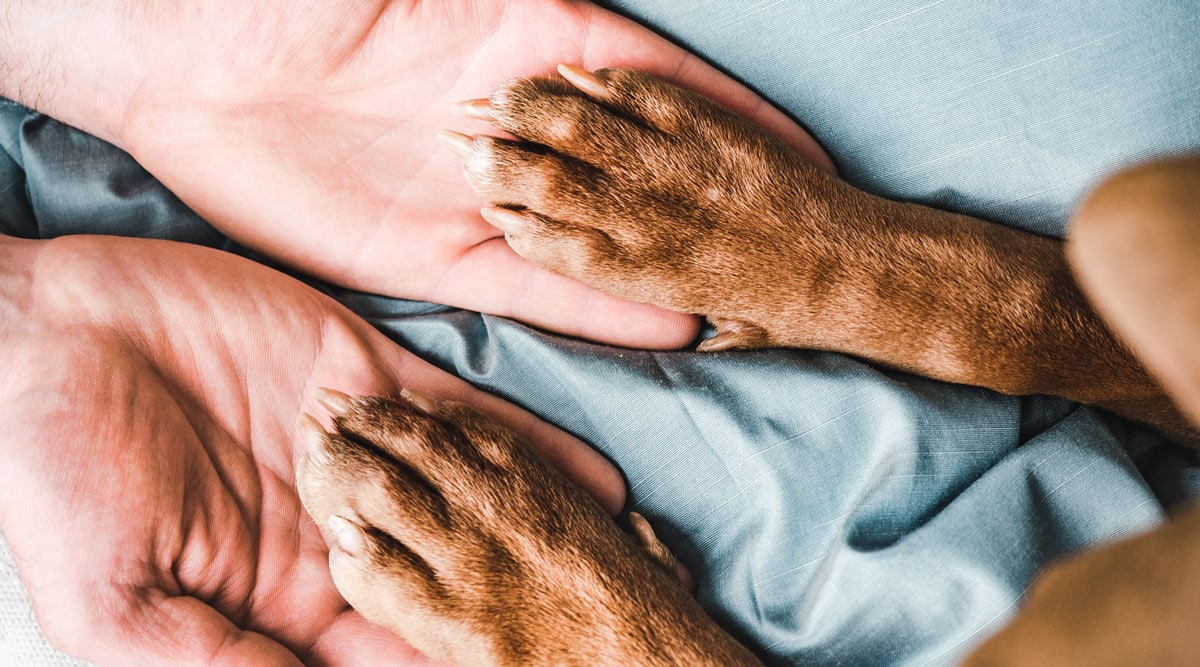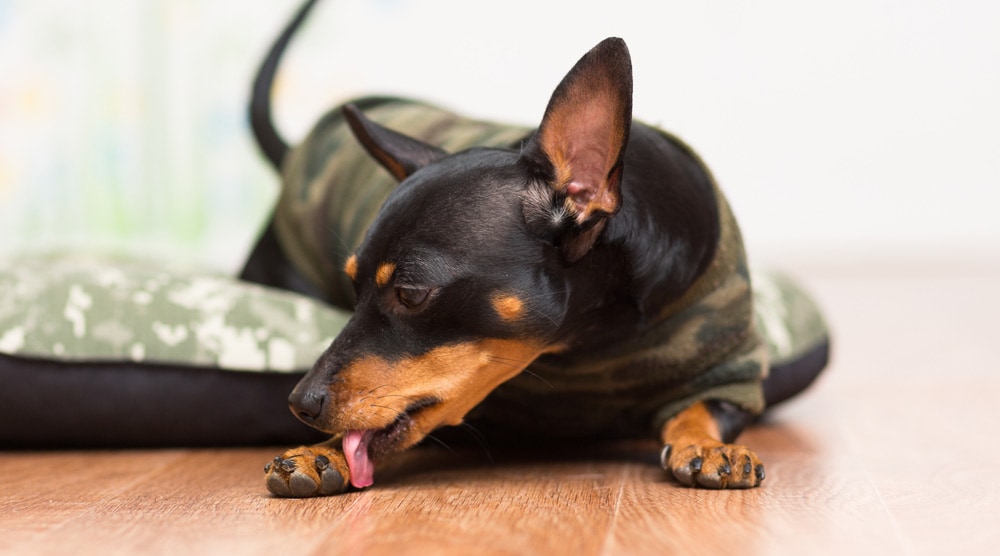Have you noticed that your dog’s paws are red and irritated? Or is your pet licking their paw pads more often than normal?
If so, then your dog could be suffering from pododermatitis – inflammation of the paw pads. Pododermatitis can be triggered by various medical issues, including allergies, wounds, foreign objects, and even stress.
In this article, we’ll discuss the most common reasons for red paws in dogs. We’ll also talk about potential treatments and when to visit a vet.
Contents
Symptoms That Accompany Red Paws in Dogs
Red paws are often a sign of inflammation of the paw pads, otherwise known as pododermatitis. The inflammation can occur on the pads themselves, or in the interdigital spaces or nail folds.
Pododermatitis is a symptom of an illness though – not a specific medical condition by itself. For this reason, it’s important to look for other potential signs of illness in your dog. These can help your vet to narrow down the potential causes of red paws and come to an accurate diagnosis.
Some additional symptoms to watch out for include:
- How many paw pads look red and inflamed
- Limping or discomfort when walking
- Excessively licking or biting the paw pads
- Other areas of irritation or inflammation on the skin
- Unpleasant odour from the paw pads
- Pink, yellow, brown, or red fur around the affected paw pads due to saliva staining (caused by excessive licking)
- Behaviour changes
As mentioned in a 2016 study into canine pododermatitis, uncovering the underlying cause of red paw pads is key to a positive outcome. Treatment varies greatly depending on what’s causing the inflammation or irritation, so a vet checkup is essential.
It’s also important to remember that inflammation or irritation in the paw pads can be a vicious cycle. The more discomfort the dog is in, the more likely they are to bite or lick the affected area. This causes more irritation and more licking, resulting in continuous inflammation.
Related Article: Why Are My Dog’s Paws Pink?

Your Dog May Be Protective of Their Inflamed Paws
Red paws can be a sign of discomfort and pain for your dog. Understandably, this can mean the dog is reluctant for anyone to touch or examine the area.
So, if your dog shows signs of distress or reluctance when you try to inspect their paws, it’s best to respect their boundaries. Even the most gentle dog may react defensively if they’re in pain.
Potential Causes of Red Paws in Dogs
There are many potential causes of red paws in dogs. These range from acute injuries, such as cuts or burns, to chronic medical conditions.
We’ve listed the most common causes of pododermatitis below. But you should contact a vet if your dog is in pain or discomfort, as paw problems can greatly affect your pet’s quality of life.
Skin Burns and Blisters
Pavements can get dangerously hot during warm summer weather. If your dog walks on them without protection, it can cause painful burns that turn the paw pads red.
Burns are often extremely painful to your dog. They can also cause skin peeling and typically affect all of the paws.
Environmental Allergies
Allergies are one of the most common causes of red paws. If your dog’s paw pads come into contact with a potential allergen, the subsequent allergic reaction can cause the area to become inflamed, red, and itchy.
There are many environmental allergens that could affect the paws. These include certain types of cleaning products, dust mites, mould, pollen, or grass.
So, if you notice your dog persistently biting or licking their paws, or showing signs of discomfort in other areas, then allergies could be the cause. You should discuss these symptoms with your vet.
Note: Exposure to pesticides and rock salts can also cause paw pad irritation, although this is not typically due to an allergy.
Rock Salt Exposure
During winter, roads and pavements are often covered with rock salt to provide extra grip for us humans. Unfortunately, rock salt can irritate a dog’s paw pads, leading to redness and itchiness.
Rock salt is also toxic to dogs. Make sure you rinse your dog’s paws off before they go indoors, otherwise there is a risk they will lick off the salt.
Bacterial Infections
A bacterial infection can sometimes cause inflammation in the paw pads. The thick paw skin usually prevents bacteria from taking hold, but this barrier can become compromised due to injury, ingrowing hairs, and allergies.
Bacterial infections in the paws can cause a range of symptoms. Aside from redness and inflammation, the dog may also suffer from ulcers and hair loss. You’ll also probably notice your dog excessively licking and biting at the area.
Veterinary treatment is required if your dog is suffering from bacterial infections. They will most likely prescribe antibiotics, along with topical treatments in some cases.
Fungal Infections (Including Yeast Infections and Ringworm)
Similar to bacterial infections, fungal infections can cause redness and inflammation. They may also cause discharge, flakiness, foul odours, and crusty skin.
You should always visit a vet if your dog has a fungal infection. Different types of fungus require specific treatments, so it’s important to get an accurate diagnosis.
Parasites
Fleas, mites, ticks, and other parasites can all irritate your dog’s skin. If these parasites are around the paw pads, then your dog may bite and lick the area in an attempt to get relief, leading to redness and inflammation.
Hookworms can also cause inflammation in the paw pads. These parasites burrow into the skin of a dog’s feet, resulting in redness and itchiness, before migrating to the gut. Fortunately, hookworm is a relatively rare type of parasite in most areas.
While the naked eye can see ticks and fleas, most other types (including mites) often need a skin scrape to confirm the diagnosis. An exception is harvest mites, which are often visible as tiny orange dots on the pads.
Foreign Objects
A foreign object caught between the toes or lodged in the paw pad can cause your dog to persistently bite and lick the area. This can lead to inflammation and redness.
If your dog allows it, check the paws for any obvious objects that have become stuck. You may be able to remove the object with tweezers, although it’s always best to visit a vet to ensure it’s removed safely.
It’s also worth noting that the object may not be visible. For example, grass seeds can become embedded under the skin. Once the wound has healed, it can be impossible to see where they entered, so the only sign might be that your dog is licking the area.
“In the warmer months, I see grass awns in paw pads almost every day,” says vet Dr Linda Simon. “We can usually identify them as there is a bulbous pink swelling with a small but visible hole.”
Wounds
A cut or scrape can cause direct inflammation on a dog’s paw pad. The dog is also likely to lick the area, which can lead to secondary inflammation and irritation.
You should always take your dog to a vet if you see a noticeable wound on their paws.
Interdigital Cysts
Cysts can grow between your dog’s toes. They appear as small, inflamed bumps that can cause ongoing pain for your pet. Cysts can also rupture or become infected.
Dogs with interdigital cysts may constantly lick the area to get relief from the discomfort. This can cause redness and inflammation.
Any dog can develop cysts. However, they appear to be more common in dogs who are overweight and have short fur. They are also more likely to develop in dogs with allergies.
Canine Cognitive Dysfunction
Canine Cognitive Dysfunction (CCD) can cause repetitive behaviours in dogs, including excessively licking the paws. Over time, the licking can cause redness, soreness, and irritation to the paw pads, even though there isn’t an underlying medical cause.
You should always visit a vet if you suspect your elderly dog is suffering from CCD. Other signs to watch out for include waking up at night, pacing, repetitive behaviours, or anxiety.
Thoughts on CCD from vet Dr Linda Simon: “I find CCD is often present alongside arthritis and joint pain in our senior canine citizens. When in pain, dogs can compulsively lick joints. So, ask your vet to perform an orthopedic exam if your senior has been licking the joints in their paws (or elsewhere).”
Nettle Rash
Nettles can cause the paw pads to become intensely itchy and red. This usually happens suddenly after the dog’s paws have had contact with the nettles on a walk.
If your dog has walked on nettles and developed a rash, you should contact a vet as they may need antihistamines. You can also use soapy water to provide relief. In most cases, the symptoms of nettle rash resolve within several hours.
Stress or Boredom
Dogs who are chronically stressed, or not getting enough mental stimulation and physical exercise, may develop repetitive behaviours. These behaviours are a way for the dog to relieve some of the negative feelings they are experiencing.
A common example of stress behaviour is biting or licking the paws. This can quickly lead to inflammation and irritation of the paw pads, along with a noticeable redness.
How to Treat Your Dog’s Red Paws (And When to Visit a Vet)
If you notice your dog’s paws are red, irritated, or inflamed, then it’s important to take action. Paw issues are not something that should be ignored.
- Inspect the affected paws. Begin by examining the paws – as long as your dog doesn’t get defensive or protective. Look for wounds and foreign objects. If you spot a wound or nail damage, schedule a vet appointment immediately. You might be able to remove small objects with tweezers, but take your dog to a vet if it doesn’t come out easily.
- Rinse the paws. If there’s no visible wound, a gentle rinse of your dog’s paws with warm water can help wash away allergens or substances that might be irritating the skin.
- Observe your dog closely. Watch to see whether the inflammation or licking is reduced after rinsing the paws and removing small foreign objects. Also, keep an eye out for other symptoms of illness.
- Contact your vet. If your dog persistently licks their paws, has had red paws for more than 24 hours, or is showing other symptoms of illness, then it’s time for professional veterinary advice. Depending on the underlying cause, your vet may recommend treatments ranging from corticosteroids (to reduce inflammation) to surgery to remove foreign objects.
How to Protect Your Dog’s Paw Pads
- Inspect your dog’s paws regularly. Catching a paw issue early can make it much easier to treat. Regularly inspecting your dog’s paw pads can help with this, while also ensuring that your dog becomes accustomed to having their paws checked. Just make sure you give your dog lots of praise and treats so they develop positive associations with a paw check!
- Rinse your dog’s paws after every walk. Rinsing removes potential allergens or chemicals that might cause inflammation and redness. It also gets rid of chemicals that might otherwise be licked when your dog is grooming.
- Keep up with your dog’s anti-parasite treatments. Ticks, fleas, and other parasites can affect your dog’s paws and overall health. Discuss prevention treatments with your vet to keep these parasites from infecting your dog.
- Be careful about which products you use to clean your home. Look for natural products that are safe for pets. It’s also a good idea to keep your dog in a different room while cleaning, and thoroughly wash away any cleaning products before they are allowed back in.
- Stay alert for sharp objects on walks. Broken glass, nails, and other sharp objects can cause severe wounds to your dog’s paw pads. Be careful when walking and always look for potential dangers.
- Avoid walking on hot pavements. Burns from boiling pavements are a common cause of paw redness – and they can be extremely painful. Walk during the coolest parts of the day and always check the pavement temperature before your dog steps on it.
- Provide dog boots for harsh terrain. Dog boots are a great way to protect your dog’s paws, particularly in cold conditions or on rugged ground.
- Trim your dog’s nails. Long nails are more likely to snag, which can cause injury, pain, and inflammation.
- Always take your dog to the vet if they have a paw problem. Healthy paw pads are essential for your dog’s well-being, so it’s essential to get professional veterinary advice – especially if the red paws have lasted more than 1-2 days (or are accompanied by other symptoms).
Summary
Red paws are usually a sign of inflammation and irritation. There are many potential causes, ranging from minor wounds to serious infections.
Contact your vet if you notice paw redness, as an accurate diagnosis is essential for effective treatment. An urgent vet checkup is particularly important if the redness lasts more than a day, your dog is in distress, or there are other noticeable symptoms of illness.
Do you have any questions about why your dog’s paws might be red? Please let us know in the comments section below.




